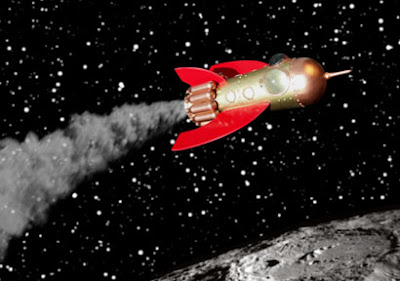Now, she dubs her low-cost rocket venture ethos 'spacepunk', so we know we have a kindred spirit here. The interview was fun and, not to put too fine a point on it, just go listen to it (or read the transcript). The short answer, for the purposes of this column, is "if it meets size, weight and deployment specs, sure!"
 |
| Flash Gordon (by Brian Fies) |
Looking at the technical issues, we have the three mentioned-- size, weight and deployment. If it ain't the right size or it's too heavy, it ain't gonna fly. That's whether you make it of wood, metal, or pasta. TubeSats have a specific deployment shape and bracket hardware so they can slide out of the rocket into their orbital slot. We can lathe a wooden satellite to those specs. So our big three-- size, weight, and shape-- aren't a problem.
Past that, I came up with four other items to consider before building a wooden satellite: structural, thermal, outgassing, and shielding properties. We'll tackle that last one first-- shielding. You want your satellite to not create electronic or magnetic noise in your instruments. Hey, turns out wood is great for this-- no electrical properties at all! Score one for wood.
Does wood have sufficient structural strength to support a satellite? If you can pass the shake-and-drop testing so you know you'll survive the pounding and vibrations of launch, sure! After you're in order, you don't need much of anything to keep it together. Most satelites are gossamer bits of wisp and fancy already, with minimal material to keep weight down. You don't need structure in space, just a skeleton frame. There are no forces (other than mild solar pressure and a bit of dust) to knock you around.
However, we do have to worry about dessication. Space will suck all the water out of the wood, and dry wood cracks. So we can expect our satellite to become more fragile and to lose its precise shape the longer it stays in orbit. But again, once in orbit, there's no impacts or forces to worry about. So score two for wood.
The thermal properties of a satellite are important. Typically, you want to shield your instruments and circuits so they suffer fewer temperature extremes. When the sun is shining on you in space, you rapidly get hot. When the sun isn't shining, you get cold. For a picosatellite like ours, both metal and wood don't provide insulation, but they do keep direct sunlight off of the more sensitive innards. So this is also a win for wood, score three.
The last issue to worry about is outgassing. I'd mentioned how space sucks out the water from the wood. All materials in space outgas, which is to say, the components that are liquid (at zero pressure and the temperature ranges in space) evaporate out. This can be a problem because, when they evaporate off "part A", they can deposit or contaminate "part B".
Imagine you have a lens glued onto a telescope. Outgassing means that glue vapor will come off the glue, and potentially deposit on the lens. And then, when things cool down, the lens now has glue stuck on it. That's an example of the sort of problem outgassing can cause.
Wood has organic compounds. It's pretty clear we shouldn't varnish our satellite, as varnish (even on Earth) is basically smelly stuff. Heat it and drop the pressure, and I fear for our detectors. Similarly, we'd want to go with a non-fragrant wood-- no pine tar evaporating off onto our detectors. So outgassing is the tricky property, something we'd want to test in our vacuum chamber on earth.
Testing is easy. Put a microscope slide or box around the wood sample and put it into a vacuum. Cool it, heat it, cool it, heat it. After a few cycles, let it sit, then open the chamber and measure what got deposited on the slide. So we can consider outgassing a critical concern, but certainly one that is controllable. Score four for wood, no barriers remain.
Between this and Randa's enthusiasm, I see no reason not to fly a wooden satellite, Obviously "Project Calliope", a straightforward metal satellite, is preoccupying my satellite building time. But after Calliope's launch, perhaps someday we'll see the launch of Dr. Alex's Patented Aetheral Circulorbital Ionoscopiter?
Alex
Track The Satellite Diaries via RSS feed and Twitter @skyday (or go slumming in my main column, the Daytime Astronomer)





Comments